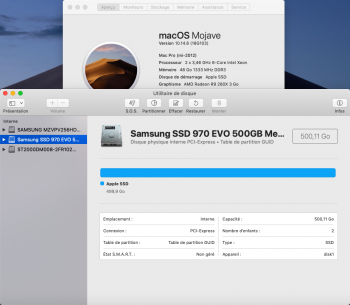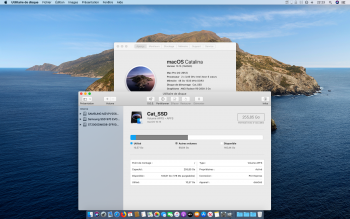Try this for the last commandSo I followed all steps and after reboot no dice. I’m getting ready to throw in the towel!
sudo kextcache -system-prelinked-kernel
Try this for the last commandSo I followed all steps and after reboot no dice. I’m getting ready to throw in the towel!
So I followed all steps and after reboot no dice. I’m getting ready to throw in the towel!
Does it can work in MacOS 10.14.6?It is well known that macOS sees PCI drives in a cMP as external. In the past, there have been several attempts to fix this annoyance, typically through codeless kexts and driver patches. However, these approaches are far from perfect.
Codeless kexts affect the properties of all (even non-PCI) drives. We therefore have to settle for calling all drives SATA or PCI. Patches can be dangerous, especially if applied to critical kexts. After system updates, these modifications can prevent the system from booting. There are also bootloader approaches, but these are better suited for hacks and not real Macs.
The problem is not just cosmetic. Improperly identified drives can cause issues for Boot Camp Assistant and the macOS installer.
I am currently working on an actual kext that addresses the problem. The kext simply changes the pertinent properties of PCI drives so that they can be seen as internal. So far, the approach works nicely with the 256 GB Apple SSUBX and the 240 GB Kingston HyperX Predator, the drives which I possess. This is how the drives now appear, for example, under Storage in About this Mac:
View attachment 780549
If there is interest in the community for the kext, I will make it available. However, to support other drives, particularly NVMe ones, I would need the names of PCI drives reported in System Information:
View attachment 780555
And, of course, some brave testers. Let me know if you're interested!
Current device list: Innie should now work with any SATA (AHCI) or NVMe drive.
Please refer to Post #9 for the kext and installation instructions.
Yes it works in macOS 10.14.6Does it can work in MacOS 10.14.6?
And the NVMe SSD can be full speed or not?
Because the PCI Express will be internal in MacOS?
Thanks for your reply.Yes it works in macOS 10.14.6
Just follow post 9 and run this command as well
sudo nvram boot-args="$(nvram boot-args | sed $'s/boot-args//;s/\t//g') -lilubeta -inniebeta"
It’s cosmetic, and it will run at the correct speed
Thanks for your reply.Yes it works in macOS 10.14.6
Just follow post 9 and run this command as well
sudo nvram boot-args="$(nvram boot-args | sed $'s/boot-args//;s/\t//g') -lilubeta -inniebeta"
It’s cosmetic, and it will run at the correct speed
Does it can work in MacOS 10.14.6?
And the NVMe SSD can be full speed or not?
Because the PCI Express will be internal in MacOS?
Yes it works in macOS 10.14.6
Just follow post 9 and run this command as well
sudo nvram boot-args="$(nvram boot-args | sed $'s/boot-args//;s/\t//g') -lilubeta -inniebeta"
It’s cosmetic, and it will run at the correct speed
A quick question: I have Lilu with Innie installed on my cMP 4.1 flashed to 5.1. I followed the instructions in post #9 and all worked well. However whenever SIP is turned back on, Lilu and Innie get disabled. The only way I can get them to stay loaded is to disable SIP. Is there a work around for this, or do we actually need to leave SIP disabled?Once the kext installed, SIP can indeed be re-enabled.
Boot into recovery open terminal and run these commandsA quick question: I have Lilu with Innie installed on my cMP 4.1 flashed to 5.1. I followed the instructions in post #9 and all worked well. However whenever SIP is turned back on, Lilu and Innie get disabled. The only way I can get them to stay loaded is to disable SIP. Is there a work around for this, or do we actually need to leave SIP disabled?
I have a Samsung SSD 970 EVO Plus 500GB, is that covered?
I have a Samsung SSD 970 EVO Plus 500GB, is that covered?



thanks @cdf @alphascorp ! is there a single page as a guide as alot going on everywhere couldnt see instructions..
That was it. Thank you. @alphascorp@pascalsrumours
If this is the detail of the manipulation you are looking for please read @cdf's message #9 on the first page of this post.
Hello, I see my disk externally, does the procedure ( post #9) also work under HIGH SIERRA? thank you for your answer

